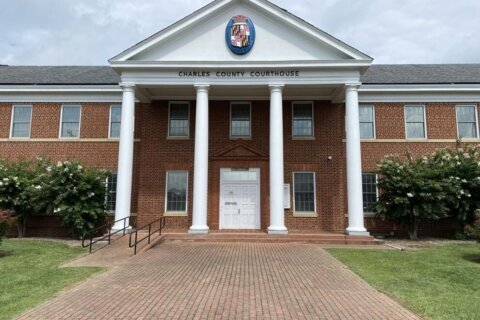This article was republished with permission from WTOP’s news partners at Maryland Matters. Sign up for Maryland Matters’ free email subscription today.
A federal loan that Maryland is counting on to finance the new Nice/Middleton Bridge is in jeopardy because U.S. Department of Transportation officials have concerns about bicycle and pedestrian safety on the new span.
That $200 million loan is expected to cover approximately one-third of the cost of the new bridge, which is about 60% complete.
A top Maryland Transportation Authority official said last week the loan is in “significant jeopardy” and that the state might need to find alternative financing. A second official said the difficulty in securing the loan is tied to the state’s 2019 decision not to fulfill its pledge to keep bikes and motor vehicles apart.
When the state decided to replace the 80-year-old bridge, which connects Charles County and King George County, Va., Gov. Lawrence J. Hogan Jr. (R) said the new, wider span would have distinct and separate lanes for motor vehicles, bicycles and pedestrians.
The authority later reversed course, citing cost, an estimated $58 million that was re-budgeted to widen a portion of I-95 in Harford County. The decision angered cycling enthusiasts.
Because the replacement bridge is partially complete, speakers told the authority’s board on Thursday that the only viable option is to repurpose the existing span into a hiker-biker trail when the new bridge opens.
Champe Burnley, immediate past president of the Virginia Bicycling Federation, said keeping the existing bridge standing would create a 52-mile trail between the two states, as the bridge is adjacent to trails on each side of the Potomac.
“Trails like that draw tourists,” he said. “They attract businesses. They’re an economic engine.”
Burnley noted that Congress included $11 billion for bike and pedestrian safety in the just-passed infrastructure bill — a fund that didn’t exist when the board dropped the bike lane.
Diana Donahue, a member of the Oxon Hill Bicycle and Trail Club, scoffed at the safety measures that the MDTA has touted for the new bridge.
“A flashing light that says there’s a cyclist on the bridge — I think it would make as much sense… to hand out targets to them to put on their backs [that] say ‘hit me,’” she said. “We’re so much better than this.”
MDTA Executive Director James F. Ports Jr. defended the decision to repurpose the bike lane money to improve a portion of southbound I-95.
“The bottleneck and that lane configuration created a problem with increased crashes, injuries and deaths in that area,” he said. “I think that decision — in most people’s minds — was a pretty easy one.”
He said the state offered to sell the old bridge to Charles County and the Commonwealth of Virginia, but officials were scared off by the maintenance costs.
Greg Hinchliffe, a retired pilot who said he has biked all over the world, said he would feel more comfortable biking “on the Beltway” than the new bridge. He said the state would save “a gazillion dollars” not demolishing the existing span.
Transportation Secretary and MDTA Board Chair Greg Slater noted that the decision to drop the bike lane occurred before he was tapped to lead the agency.
“I have a couple of thoughts and ideas that I want to explore a little bit with people outside MDTA,” he said.
In pressing for a reassessment of the current plan, Donahue noted that more people are exercising now than ever.
“People who are active, who ride bikes, who walk, are a part of the future,” she said. “With the pandemic, people are coming out more to exercise, to stay healthy, to stay outside and to stay sane.”







